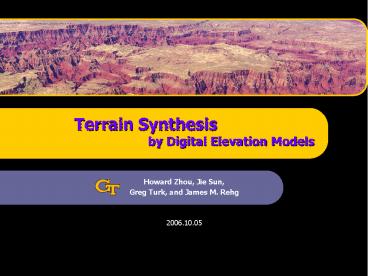Terrain Synthesis by Digital Elevation Models - PowerPoint PPT Presentation
Title: Terrain Synthesis by Digital Elevation Models
1
Terrain Synthesis by Digital Elevation Models
- Howard Zhou, Jie Sun,
- Greg Turk, and James M. Rehg
- 2006.10.05
2
Table of Contents
Introduction Feature extraction Feature
matching Patch stitching Conclusion
- Introduction
- Feature extraction
- Feature matching and alignment
- Patch stitching
- Conclusion
3
Why?
Introduction Feature extraction Feature
matching Patch stitching Conclusion
- Numerous applications
- Landscape design
- Flight simulators
- Feature film special effects
- Computer games
4
Previous Work
Introduction Feature extraction Feature
matching Patch stitching Conclusion
- Terrain synthesis
- Fractal model
- fBm - fractional Brownian motion (Mandelbrot
1982) - Midpoint displacement, recursive subdivision
(Fournier 1982, Miller 1986, Voss 1985, Lewis
1987, Szeliski, et al. 1989) - Erosion model
- Physical erosion simulation (Kelley, et al. 1988)
- Combination of Both
- Fractal terrains with erosion features (Musgrave
et al. 1989) - Most commercial landscaping software such as
Terragen, Bryce, Vue dseprit, and Mojoworld,
etc.
5
Previous Work
Introduction Feature extraction Feature
matching Patch stitching Conclusion
- Limitation of previous terrain synthesis
approaches - Limited control by user (parameter tuning)
- Hard to capture real terrain style
6
What If ?
Introduction Feature extraction Feature
matching Patch stitching Conclusion
7
(No Transcript)
8
Related Work
Introduction Feature extraction Feature
matching Patch stitching Conclusion
- Patch based texture synthesis
- Image quilting (Efros and Freeman 2001), Graphcut
(Kwatra et al. 2003) - Feature guided texture synthesis
- Image analogy (Hertzmann et al. 2000), Feature
matching and deformation (Zhang et al. 2003, Wu
and Yu 2004)
9
Terrain synthesis is not texture synthesis
Introduction Feature extraction Feature
matching Patch stitching Conclusion
- Terrain synthesis is not simply texture synthesis
on height fields. - Terrain synthesis must preserve global features
such as ridges and valleys. - Terrain synthesis must be globally controllable.
- Unlike general textures, terrain doesnt have
natural boundaries.
10
Our Contribution
Introduction Feature extraction Feature
matching Patch stitching Conclusion
- First example-based terrain synthesis
- User control via feature sketches.
- Feature-based approach to matching and placement
of large curvilinear terrain features. - Tree-ordered patch placement algorithm.
- Multiple terrain style.
11
Procedure
Introduction Feature extraction Feature
matching Patch stitching Conclusion
- Feature Extraction
- Extract important terrain features (valleys,
ridges, ) - Feature matching and deformation
- Match terrain features between user sketch and
terrain data to find candidate patch - Use deformation to align features
- Patch stitching
- Use graph cuts and Poisson interpolation to
remove visible seams between neighboring patches
12
Flowchart
Introduction Feature extraction Feature
matching Patch stitching Conclusion
Patch stitching
Feature extraction
Matching and deformation
13
Feature Extraction
Introduction Feature extraction Feature
matching Patch stitching Conclusion
- Finding ridges and valleys
- Branches and Ends
- Path Features
- Changs PPA algorithm (Profile recognition and
polygon breaking)
End
Branch
Path
14
Why PPA?
Introduction Feature extraction Feature
matching Patch stitching Conclusion
Grand Canyon (shaded relief)
Edge detection result
PPA result
15
PPA explained
Introduction Feature extraction Feature
matching Patch stitching Conclusion
Target Connection
Profile Recognition
Polygon Breaking
Branch Reduction
16
In action
Input
17
In action
Profile Recognition
18
In action
Polygon building
19
In action
Polygon Breaking
20
In action
Branch Reduction
21
In action
Result
22
Feature placement (tree traversal)
Introduction Feature extraction Feature
matching Patch stitching Conclusion
23
Why is order important?
Introduction Feature extraction Feature
matching Patch stitching Conclusion
Raster-scan patch placement (ncc)
Tree traversal
24
Feature alignment
Introduction Feature extraction Feature
matching Patch stitching Conclusion
- Most of the time, the feature patches need
alignment before they can be used. - Thin plate spline mapping for feature deformation
- Two sets of corresponding feature points from
feature matching - Small deformation in terrain does not alter
terrain style
Branch
End
Path
25
Feature Patch Matching
Introduction Feature extraction Feature
matching Patch stitching Conclusion
- d Deformation energy from TPS warping
- g Graphcut seam cost
- f Feature dissimilarity
- i Other user specified constraints
26
Non-feature placement
Introduction Feature extraction Feature
matching Patch stitching Conclusion
- SSD- based search (accelerated)
- Fill the synthesized height map
27
Graphcut
Introduction Feature extraction Feature
matching Patch stitching Conclusion
- Graphcut Textures Image and Video Synthesis
Using Graph Cuts (Kwatra et al. 2003)
28
Poisson interpolation
Introduction Feature extraction Feature
matching Patch stitching Conclusion
- Poisson image editing (Perez et al. 2003)
- Modify the gradient and reconstruct
29
Mount Jackson
30
(No Transcript)
31
Grand Canyon
32
(No Transcript)
33
Flathead National Forest, MT
34
(No Transcript)
35
Mount Vernon, KY
36
(No Transcript)
37
(No Transcript)
38
Middle Earth
39
(No Transcript)
40
(No Transcript)
41
(No Transcript)
42
(No Transcript)
43
(No Transcript)
44
Conclusion
Introduction Feature extraction Feature
matching Patch stitching Conclusion
- Weve presented an image-based algorithm for
terrain synthesis - It provides user control by intuitive sketch
- It preserves terrain style embedded in the
original height field
45
Cape Girardeau, MO (failed)
46
(No Transcript)
47
Results
- Show video
48
PPA in action
Introduction Feature extraction Feature
matching Patch stitching Conclusion































